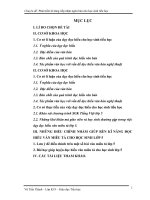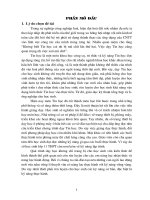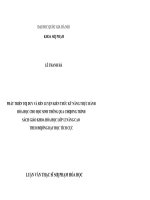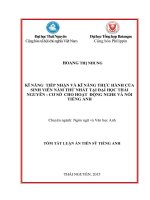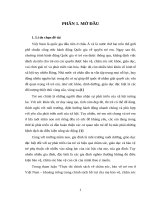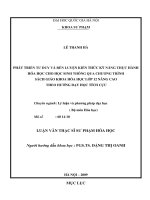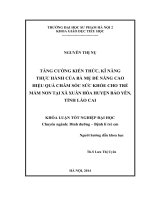Kĩ năng tiếp nhận và kĩ năng thực hành của sinh viên năm thứ nhất trong Đại học Thái Nguyên: Cơ sở cho các hoạt động nghe và nói tiếng Anh
Bạn đang xem bản rút gọn của tài liệu. Xem và tải ngay bản đầy đủ của tài liệu tại đây (3.73 MB, 139 trang )
THAI NGUYEN UNIVERSITY
Socialist Republic of Vietnam
BATANGAS STATE UNIVERSITY
Republic of the Philippines
1
RECEPTIVE AND PRODUCTIVE SKILLS AMONG FRESHMAN
STUDENTS IN THAI NGUYEN UNIVERSITY SYSTEM : BASIS
FOR LISTENING AND SPEAKING ACTIVITIES
A Dissertation Proposal
Presented to
The Faculty of Graduate School
Batangas State University
Batangas City, Philippines
In Partial Fulfillment
Of the Requirements for the Degree
Doctor of Philosophy
Major in English
By:
Hoang Thi Nhung (Dimples)
December 2014
THAI NGUYEN UNIVERSITY
Socialist Republic of Vietnam
BATANGAS STATE UNIVERSITY
Republic of the Philippines
1
TABLE OF CONTENTS
Page
TABLE OF CONTENT i
LIST OF TABLE iii
CHAPTER
I. THE PROBLEM 4
Introduction 4
Statement of the Problem 10
Scope, Delimitation and Limitation of the Study 12
Significance of the Study 13
II. REVIEW OF LITERATURE 15
Conceptual Literature 15
Research Literature 34
Synthesis 40
Theoretical Framework 43
Conceptual Framework 46
Hypothesis 48
Definition of Terms 48
III. RESEARCH METHOD AND PROCEDURE 51
Research Environment 51
Research Design 53
Subjects of the Study 53
THAI NGUYEN UNIVERSITY
Socialist Republic of Vietnam
BATANGAS STATE UNIVERSITY
Republic of the Philippines
2
Data Gathering Instrument 55
Data Gathering Procedure 57
Statistical Treatment of Data 58
IV. PRESENTATION, ANALYSIS AND INTERPRETATION OF DATA 59
INTRODUCTION 83
V. SUMMARY, CONCLUSION AND RECOMMENDATION 101
Conclusions 111
Recommendations: 112
BIBLIOGRAPHY 113
APPENDICES ………………………………………………………… 124
A. Letters of Request
B. Questionnaires
C. Documentations
CURRICULUM VITAE
THAI NGUYEN UNIVERSITY
Socialist Republic of Vietnam
BATANGAS STATE UNIVERSITY
Republic of the Philippines
3
LIST OF TABLES
Table Title Page
1 Distribution of Sample Respondents 54
2 Gender Profile of the Student Respondents 59
3. Residence Profile of the Student Respondents 62
4. Parent's Education Profile of the Student Respondents 63
5. Years of Exposure to English Media of the Student RespondentsError! Bookmark not defined.
6. Type of English Media Exposure of the Student Respondents 65
7. Level of student's performance in the listening skill test. 66
8 Ranking of student's performance in the listening skill test
according to degree of difficulty 78
9. Ranking of student's performance in the speaking skill test
according to degree of difficulty 79
10. List of 8 listening and speaking skills validated to be employedError! Bookmark not defined.
in teaching the Basic English course by the respondents.Error! Bookmark not defined.
11. List of 8 listening and speaking skills and their frequency of use
by the respondents. Error! Bookmark not defined.
12. List of 8 listening and speaking skills and their degree of
importance. Error! Bookmark not defined.
13. Parameters used as basis for the design of remedial learning
and speaking activities. 80
THAI NGUYEN UNIVERSITY
Socialist Republic of Vietnam
BATANGAS STATE UNIVERSITY
Republic of the Philippines
4
CHAPTER I
THE PROBLEM
Introduction
In the day to day life, language plays a very vital role in
communication. Most of daily activities need the interplay of these four
language skills listening, speaking, reading and writing. A balance among
them should be required for an individual to become an efficient and
effective speaker of the language but there seem to be factors that lead to
its incompleteness causing problems to users of the second language.
It has been claimed that over 50 percent of the time that students
spend functioning in a foreign language will be devoted to listening
(Nunan,1998). Despite this, among the four language skills, listening is
taken for granted, it is least understood and most overlooked. Since the
natural precursor to speaking is listening, in a person‟s first language, the
early stages of language development are dependent on listening. In first
language education on going attention is needed for both listening and
speaking development. Before, first language speakers were taken for
granted in terms of instruction relative to reading and writing but not for
listening and speaking because these skills were acquired by native
speakers automatically.
THAI NGUYEN UNIVERSITY
Socialist Republic of Vietnam
BATANGAS STATE UNIVERSITY
Republic of the Philippines
5
In the 1980‟s, listening had a very important role in second language
learning. This notion resulted to a corresponding drop in the importance of
speaking in the early stages of learning and that even in a course it is
discouraged to speak early. Based on the insight on what it means to learn
a language support the contention of giving emphasis to listening and delay
speaking.
One way of learning the language is attributed to listening. There are
approaches to language teaching that gave importance to listening. Nord‟s
(1980) view was clearly expressed when he stated that some people now
believe that learning a language is building a map of meaning in the mind
and these people believe that talking may indicate that the language was
learned, but they do not believe that practice in talking is the best way to
build up this cognitive map in the mind and in doing this, they feel that the
best method is to practice listening. Through listening, the learner is given
information from which the knowledge necessary for using the language is
built up. The learner can start speaking when knowledge is built up.
There are many benefits if learners concentrate to listening and delay
speaking. One of these is cognitive benefit wherein there will be no
overloading relative to focus of the learner on two or more skills. Another is
the speed of coverage, wherein, since receptive knowledge grows faster
than productive knowledge, there is a possibility to experience and to learn
THAI NGUYEN UNIVERSITY
Socialist Republic of Vietnam
BATANGAS STATE UNIVERSITY
Republic of the Philippines
6
more about language through listening. Further, there is a strong effect on
motivation if there is a move to realistic communicative listening activities. It
is a psychological benefit also to have listening activities involved in
language learning as it reduces stress and in independent learning these
activities are well suited.
Listening before is viewed as passive process wherein the listener
acts as receiver of information transmitted by the speaker. Recently, a
much more active and interpretive process is attributed to listening as the
message is not fixed since it is created through interactional space between
participants. Listeners constructed meanings that are shaped by context
through the act of interpreting meaning, rather than receiving it intact
(Lynch, 2002).
Listening comprised not only of one skill but varied sub- skills. There
is better performance in comprehension questions for listeners with more
skills. A fundamental platform for second language development and
content learning is provided through experiences with meaning-focused
listening. Directed attention to perceptual processing and parsing skills
enriched these experiences. Finding an appropriate balance between
providing opportunities for listening skill development through meaning –
focused listening and through language learning focused listening which
focuses on bottom-up listening practice is needed by teachers.
THAI NGUYEN UNIVERSITY
Socialist Republic of Vietnam
BATANGAS STATE UNIVERSITY
Republic of the Philippines
7
In listening comprehension, there are problems of learners identified.
These include problems in recognizing word forms, and keeping up with
what is coming in. Learners do not have enough time to turn perceived form
into an appropriate message. Goh (2000) stated that listening problems can
occur at the levels of perception, parsing and utilization and that they can
benefit from training in listening strategies which include communication
strategies to assist comprehension, like making predictions before listening,
listening selectively, and knowing how to interrupt politely. Other problems
of learners identified in listening are not being able to discriminate or
distinguish English sounds or learners lack of phonological awareness; not
knowing the meaning of English words or lack of vocabulary; and their lack
of pacing or speed in understanding spoken language.
Speaking on the other hand is said to be acquired by all human beings
who are normally endowed without explicit instruction. Among the four
skills, speaking is the most demanding and challenging skill. It is an activity
that requires an integration of many subsystems. One of the most difficult
aspects of the spoken language is accomplished through interaction with
another speaker. Since speech is the most basic means of human
communication, for most people, knowing the language is synonymous to
the ability to speak a language. Reduced forms like contractions, vowel
THAI NGUYEN UNIVERSITY
Socialist Republic of Vietnam
BATANGAS STATE UNIVERSITY
Republic of the Philippines
8
reduction, and elision comprised fluent speech. These are features that
interact to make speaking a very important central skill.
In the oral mode, speaking is a productive skill and it is also
complicated like the other skill components of language as it involves many
aspects. There are three situations where speakers are engaged when
speaking. In interactive speaking situations, the speaker has the chance to
request from conversation partner to clarify, repeat, or slow down speaking
while in partially interactive speaking situations, the speaker can gauge
whether there is understanding of the message conveyed on the part of the
conversation partner through facial expressions and body language.
Recording a speech for radio broadcast is a form of a non-interactive
speaking situation.
A number of situational factors to help convey meaning and intention
rely on speaking. There are some characteristics that speaker must carry
out in order to become successful speaker. These include giving much time
or opportunity to the students to speak as often as possible. Allocating as
much time as possible to students talking can create the best environment
for engaging in oral activities.
The following features are considered for successful speaking
activities. These are making sure that students participation is not
dominated by a few talkative students; that students want to speak because
THAI NGUYEN UNIVERSITY
Socialist Republic of Vietnam
BATANGAS STATE UNIVERSITY
Republic of the Philippines
9
they are interested in the topic; that students have something relevant to
say; that students can be understood by anyone; and that there aren‟t
frequent interruptions while student is speaking.
There are also several factors to consider when planning for a variety
of speaking tasks to push learner‟s output. First is that learners should be
able to speak on a range of topic, as covering a good range of topics
improves learner‟s vocabulary. Range of text types is another factor that
though these text types which include intimate interpersonal interaction,
scientific exposition, and imaginative narrative were written types, they
contain spoken equivalents. As for the range of performance conditions,
planning before speaking is very important as it involves task preparation
before performance. Time pressure also affects speaking performance in
the sense that providing learner‟s ample time to perform speaking task
increase the quality of the learner‟s spoken output.
With regard to amount of support as performance condition, an
important requirement in supportive listening is providing the speaker a way
in finding needed items in language without giving overwhelming attention
to that given support. For the standard of performance affecting speaking,
while it can be supportive to speak with others, it can also be demanding.
Some problems in an English class are attributed to the failure of
some speaking activities. The problems faced by learners in speaking
THAI NGUYEN UNIVERSITY
Socialist Republic of Vietnam
BATANGAS STATE UNIVERSITY
Republic of the Philippines
10
activities include inhibition, nothing to say, the low participation, the theme
to be spoken and the use of the mother tongue. Manifestations of students
having inhibitions is stage fright whenever a student is made to speak in
front of an audience, nothing to say where students need not say anything
because they feel bored knowing that the topic is unrelated to anything they
know; low participation where students are prevented to speak due to the
dominance of students who are good English speakers and mother tongue
where students insist on using their mother tongue instead of English
language for fear of criticism. Speaking in class can be a lot of fun, raise
general learner motivation and making English language classroom a
dynamic place if the language activities are taught in a right way.
So that the researcher as a college instructor teaching Basic English
course, she is prompted to conduct a study on receptive and productive
skills of freshman students with the end view of proposing English speaking
and listening activities to enhance the students‟ receptive skills.
Statement of the Problem
This research is designed to assess receptive and productive skills
among the freshman students at Thai Nguyen University. Specifically, it
sought answers to the following questions:
1. What is the demographic profile of the respondents with reference to:
1.1 gender
THAI NGUYEN UNIVERSITY
Socialist Republic of Vietnam
BATANGAS STATE UNIVERSITY
Republic of the Philippines
11
1.2 high school graduated from
1.3 residence
1.4 parent‟s education
1.5 family income
1.6 English media exposure?
2. What is the level of the students‟ listening skills relative to:
2.1 accuracy
2.2 comprehension
2.3 vocabulary
2.4 spelling?
3. What is the level of students‟ speaking skills relative to:
3.1 pronunciation
3.2 fluency
3.3 comprehension
3.4 vocabulary
4. Are there significant relationships on the students‟ listening and
speaking skills?
5. What are the difficulties commonly met by students in:
5.1 listening
THAI NGUYEN UNIVERSITY
Socialist Republic of Vietnam
BATANGAS STATE UNIVERSITY
Republic of the Philippines
12
5.2. speaking
6. What listening and speaking activities may be suggested for
classroom purposes?
Scope, Delimitation and Limitation of the Study
This study focused on the assessment of the speaking and listening
skills of the freshman students at Thai Nguyen University.
It covers the profile of the respondents including gender, high school
graduated from, residence, parents‟ education, family income and exposure
to English media. The respondents listening skills in terms of accuracy,
comprehension, vocabulary and spelling were assessed. Part of the study
also includes the level of student‟s speaking skills in terms of pronunciation,
fluency, comprehension and vocabulary with the end view of proposing
English listening and speaking activities to enhance the receptive skills of
the students.
The study covered the four (4) Thai Nguyen Universities in Thai
Nguyen City. Fifty eight (58) teachers and three hundred and eighty (380)
freshman students were used as respondents of the study during the
Academic Year 2013-2014. The study does not include those students in
the higher levels and those who come from other colleges of TNU system
not mentioned in the study.
This study is limited on the results of the data gathered from students
and teacher respondents involved.
THAI NGUYEN UNIVERSITY
Socialist Republic of Vietnam
BATANGAS STATE UNIVERSITY
Republic of the Philippines
13
Significance of the Study
The study is deemed beneficial to the Administrators of Thai Nguyen
University, faculty of basic English, freshman students, parents and future
researchers.
Administrators of Thai Nguyen. This study can guide them in
improving their English curriculum by evaluating the different English
proficiency enhancing activities. This study will serve as a guide for the
enhancement of the existing Basic English curriculum to meet their
institutional goals and objectives.
Faculty of Basic English. This study will serve as a tool for the
faculty in teaching Basic English as they may become aware of the present
level of students‟ listening and speaking skills. This will provide them
insights on what innovative learning activities will be appropriate to enhance
the Language proficiency of their students.
First Year Students. The findings of this study will make them aware
of their level of listening and speaking skills. This would give them
information on their performance in Basic English and will be an instrument
for them to improve their weak points and enhance their over all
performance in Basic English.
Parents. Parents of the first year students will become aware of the
English performance of their children which will make them more supportive
THAI NGUYEN UNIVERSITY
Socialist Republic of Vietnam
BATANGAS STATE UNIVERSITY
Republic of the Philippines
14
and cooperative in school activities especially on the improvement of the
performance in Basic English skills of their children.
Future Researchers. This study will serve as reference for their
undertaking, the similar study can be conducted along this line to other
universities.
THAI NGUYEN UNIVERSITY
Socialist Republic of Vietnam
BATANGAS STATE UNIVERSITY
Republic of the Philippines
15
Chapter II
REVIEW OF LITERATURE
This chapter presents the conceptual and research literature,
synthesis, theoretical and conceptual frameworks of the study, hypothesis,
and definition of terms.
Conceptual Literature
The concepts discussed provide a conceptual frame of reference.
These include oral communication, the art of listening, speaking proficiency
and language learning activities.
Oral Communication. The process of expressing information or ideas
by word of mouth and verbally transmitting information and ideas from one
individual or group to another is termed oral communication (Swarthout,
Donna, education-portal.com/ academy/ lesson /oral – commu-nication/
definition-types-advantage. html # lesson). It can either be formal or
informal. There are advantages of oral communication. One of these is that
it is more personal and less formal as compared to written communication.
Another is that in oral communication, there is flexibility. It can address
conflict and problem and in a team it can maintain energy and enthusiasm
and promote moral.
According to Murphy, et. al., (1997) oral communication describes any
type of interaction that makes use of spoken words, and it is vital, integral
part of the business world, especially in the information age and that the
THAI NGUYEN UNIVERSITY
Socialist Republic of Vietnam
BATANGAS STATE UNIVERSITY
Republic of the Philippines
16
ability to communicate effectively through speaking as well as in writing is
highly valued, and demanded in business. Further, in effective
communication, it is also important to know the content, the functional
areas that give life to those ideas either in meeting or presentation. The
following are the criteria for effective communication: clear, relevant, tactful,
in phraseology and tone, concise and informative.
Oral communication means to communicate by talking, since this
implies a two-way interaction that emphasizes the communication aspect
rather than the simple act of articulation. It is effective when it is clear,
relevant, appropriate to the intended audience in phraseology and tone,
concise and informative (www.use.my ability.org uk/skills/oral-commu-
nication.html). All forms of oral communication include speeches,
presentations, and discussions. When communication matter is temporary,
a kind where direct interaction is required, it is generally recommended to
have oral communication as it implies communication through the mouth
and includes individuals conversing with each other be it direct or
telephonic conversation.
Nuval (2014) stated that oral communication deals with interaction of
communicators through the use of language which consists of systematized
vocal sounds made in the mouth, nose, and throat which are organized into
words and phrases for communication. Processing of sequences, sounds
and words, and discriminating speech sounds and words that are similar to
THAI NGUYEN UNIVERSITY
Socialist Republic of Vietnam
BATANGAS STATE UNIVERSITY
Republic of the Philippines
17
verbal comprehension are required in effective oral communication. Also
required are retaining a sequence of information, extracting meaning from
complex or abstract language or grammatical structures and understanding
non-literal language. Moreover, communication through the mouth is
required in oral communication. Considered forms of oral communication
are conversation be it direct or through telephone, speeches, presentations
and discussions. When communication is temporary, where it is required to
have direct interaction, oral communication is recommended.
Oral communication as a cycle involved two persons: the speaker and
the listener wherein the information is exchanged between them through a
common system of symbol, signs and behavior. There are several
advantages for oral communication (www.management study.
guide.com.oral communication.htm). These are: as it is interpersonal, there
is high level of understanding and transparency; there is no element of
rigidity, thus, decision can be made quickly; and it is not only time saving
but it also saves money and efforts. In case of problem resolution, oral
communication is best as it can put end to conflicts, disputes, issues and
differences. In team work, oral communication is essential aside from
promoting receptive and encouraging morale among organizational
employees. Oral communication is also effective in transferring private and
confidential matters.
THAI NGUYEN UNIVERSITY
Socialist Republic of Vietnam
BATANGAS STATE UNIVERSITY
Republic of the Philippines
18
There are also chief principles or characteristics of effective
communication which are considered keys to productive communication.
These are clearness and integrity of message to be conveyed; adequate
briefing of the recipient; accurate plan of objectives; reliability and uniformity
of the message; knowing of the main purpose of the message; proper
response of the message; correct timing; and the use of proper medium to
convey the message properly (https: sites: google.com.site/ communication
skills / you/ characteristics of effective communication).
Further, to make communication effective there are guidelines to
follow. Before communicating a message simplifying one‟s thoughts is
needed. Intent of each and every message of the individual must be
analyzed as well as knowing the physical setting before communicating.
Appropriateness must be considered when discussing with others regarding
plans for communication. The basic content of the message, the tone must
be taken into consideration when communicating, and make follow up. In
transmitting message, prepare oneself in a proper way by ensuring that
actions support communications and finally seek not to be understood but
understand. The persistent and powerful role of language and
communication in human society is reflected in oral communication.
Halliday (2008) emphasized that communication is more than merely
an exchange of words between parties; but a sociological encounter and
THAI NGUYEN UNIVERSITY
Socialist Republic of Vietnam
BATANGAS STATE UNIVERSITY
Republic of the Philippines
19
through exchange of meanings in the communication process, social reality
is created, maintained and modified. Multiple elements which result in the
success or failure of interaction comprised oral communication. Moreover,
any type of interaction utilizing spoken words, and is essential part of the
business world dubbed as information age described students are aided in
improving their own academic performance, increasing their employment
options, enhancing their subsequent professional competence and
improving their own personal effectiveness through effective oral
communication.
Oral communication skills include mix of verbal, interpersonal, and
physical strategies needed to interact confidently and effectively with a
range of audience (www.griffith.educ.au/-data/assets/pdf file/0018
/162720/oral.pdf/). When the desired effect is the result of intentional and
unintentional information sharing, which is interpreted between multiple
entities and acted on in a desired way effective communication occurs.
During communication process, the desired effect ensures that messages
are not distorted. The following should be generated through effective
communication: desired effect, maintained effect, and the potential to
increase the effect of the message.
Hymes (1972) on the other hand stated that the teaching of oral
communication skills as a contextualized sociocultural activity has become
THAI NGUYEN UNIVERSITY
Socialist Republic of Vietnam
BATANGAS STATE UNIVERSITY
Republic of the Philippines
20
the focal point in many English second learner (ESL) classrooms. Oral skills
teachers should always connect speaking, listening, and pronunciation
teaching although the focus is any one class or activity may highlight one or
another (Murphy, 1991). Oral skills classes may use reading and writing
activities as the basis or follow up for speaking activities.
In the case of English foreign language (EFL) classes, where all
students speak the same first language and English is not used outside the
classroom, these present certain challenges for the teacher. Nunan (1993)
stated that the biggest challenges of EFL teachers in the EFL classroom
are lack of motivation, getting students to speak, and the use of the first
language as well as large classes are often the norm overseas, limiting
both student opportunities to talk and teacher opportunities to provide
feedback. Curriculum which does not emphasized speaking skills but focus
on grammatical accuracy, as well as incompetent or lack of confidence of
teacher in speaking English are the other problems of EFL teachers.
Organizing class activities that are authentic, motivating, and varied are
needed by EFL teachers when teaching speaking skills. Likewise, in –class
activities, the use of authentic, engaging materials should be made basis.
The Art of Listening. The most frequently employed skill in daily
language use is listening, yet seemingly it is the most neglected area of
concern, because listening, unlike other skills, is an internal process that
THAI NGUYEN UNIVERSITY
Socialist Republic of Vietnam
BATANGAS STATE UNIVERSITY
Republic of the Philippines
21
cannot be directly observed (Morley, 1984). In addition, listening as a skill
was perceived to be the lowest in terms of its impact on the learner. In
second language instruction, this lack of attention is due to several factors.
These include focus on speaking a language where the primary explicit
concentration was on teaching learners to speak the second language as it
is believed that if one learned to speak the language, listening
comprehension would occur simultaneously; listening was used as a tool to
teach speaking but not as instructional goal in itself; and the passive
assumption that listening was a passive skill.
Yagang (1993) defined listening as the ability to identify and
understand what others are saying and further stated the it involves
understanding of the speaker‟s accent or pronunciation, his grammar and
his vocabulary, and grasping his meaning. Willis (2001) identified the
following micro-skills of listening or enabling skills: predicting what people
are doing to talk about; guessing at unknown words or phrases without
panicking; using one‟s knowledge of the subject to help one understand;
identifying relevant points, rejecting irrelevant information; retaining relevant
points; recognizing discourse markers; recognizing cohesion devices;
understanding different intonation patterns and uses of stress, as well as
understanding inferred information like speaker‟s attitude or intention.
Good listening according to Nicholas (1988) relates itself to the
following characteristics of spoken language: redundancy which is
THAI NGUYEN UNIVERSITY
Socialist Republic of Vietnam
BATANGAS STATE UNIVERSITY
Republic of the Philippines
22
considered both an advantage and a disadvantage to a listener; untidiness
in spontaneous conversation where it often contains language structures
that may not be grammatical, unfinished utterances, pauses, and even
moments of silence, and environmental interferences where spoken
language requires the hearer to cope with environmental uncertainties such
as noise, the voice quality and the emotional states of interlocutors, and the
loudness or lack of it.
There are cited reasons why listening is a difficult process. One of
these is the content and linguistic features found in listening materials
which make the learners have difficulty in distinguishing or recognizing
individual words in the stream of speech; the speaker in conversation which
normally resort to redundancy; the listeners which according to Anderson,
et al., (1988) are not familiar with clichés and collocations in English to
predict a missing word or phrase, as well as their lack of socio-cultural,
factual, and contextual knowledge of the target language can present
problem to comprehension because language is used to express its culture;
and the physical setting, where noise, unclear sounds resulting from poor
quality equipment can interfere with listener‟s comprehension.
There are two reasons why a person listens to a great deal of
language and these are interest and usefulness. According to Harmer
(1983) the category of interest includes listening for enjoyment, pleasure,
THAI NGUYEN UNIVERSITY
Socialist Republic of Vietnam
BATANGAS STATE UNIVERSITY
Republic of the Philippines
23
and intellectual stimulation. Burt et al (1981) on the other hand included a
focus on the roles of listening when they characterized one-way
communication as taking place when a learner would listen to or read in a
second language with the communication targeted toward the learner but
not issuing from the learner.
The importance of listening in the processes of comprehension,
retention of information in memory and acquisition of second language
competence is recognized by proponents of comprehension approaches.
Nida (1957) stated that learning to speak a language is very largely a task
of learning to hear it. Reception should precede production because
reception enables production and while it is possible to learn to understand
without speaking, it is not possible to learn to speak without understanding
(Nord, 1981). There are several effects if there is premature production.
Students are forced to go back on first language (L1) production and make
many transfer errors if they lack competence in the second language (L2).
The ability to comprehend the language completely might be interfered
with the need to produce utterances and anxiety is produced if there is
overload of tasks demands on the learner which affects their learning.
The importance of listening in communication is shown in the art of
listening (www.slideshare.Net/shivakuwar/the-art-of-listening) while others
considered it similar to reading and beginning to understand the scriptures.
Not talking anything too personal is considered one way to become a good
THAI NGUYEN UNIVERSITY
Socialist Republic of Vietnam
BATANGAS STATE UNIVERSITY
Republic of the Philippines
24
listener as well being detached in order to hear the other person (www.
huffington post.com/osi-mizraki/listening). Further, one of the most
important skills a strong leader must possess is to have effective listening
as it is needed by most small- business owners to develop since listening is
the key to managing and the mood in a company.
Mayer (2013) pointed out that listening is an active interpretation that
shapes the realities, and it is the answer to improving productivity and
increasing business with customers. Degenerative moods among
employees such as mistrust, resignation, and resentment are the results of
lack of listening while improved mood fueled by ambition and confidence,
that boosts productivity and profitability are the results of those employees
who are listened to in terms of their experiences. Further, there are five
ways to improve listening, these are to forget outdated advice, to interpret
whatever is heard, to clarify what is heard from other person, to ask open-
ended questions, and to validate what is heard.
To listen attentively to one another has also some importance. These
include to make eye contact when introduced to other person; listen
actively; listen reflectively; do not judge; and create the right work
environment (www.linkedin.com/today/post/article/the-art-of-listening).
According to Sheryl Conelley, a futurist who works in Ford Motor Co.,
there are ways on how to listen well. First is to focus on the person
